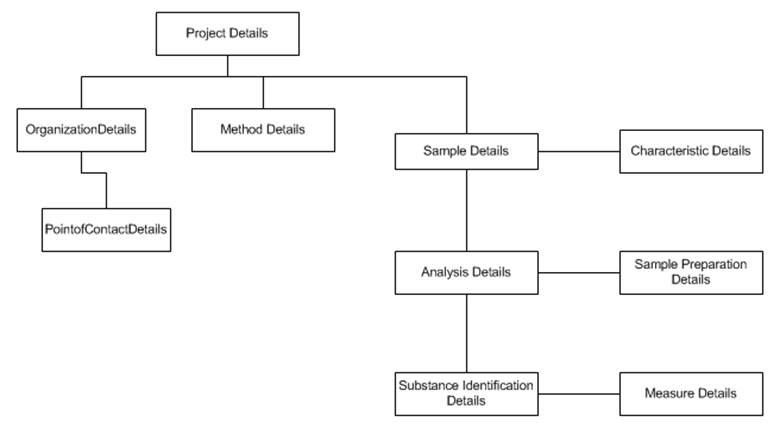Specimen Use Case for Environmental Specimen
Environmental Sample Submission Data Elements
Public Health Environmental samples cover a broad spectrum of programs, matrixes, and methods. This spectrum continues to expand frustrating efforts to harmonize data elements for both the data generator and the data consumer. When defining the data elements that are necessary to characterize environmental samples for submission to a PHL it is useful to take a step back and seek opportunities to define these data elements in a such a way that they are agnostic to programs, matrixes, and methods and provide the ability to expand. Such an approach also makes data exchange between sample submissions easier to map and harmonize. Starting with a domain model that first looks at the organization of data elements is one approach.
As an example, Figure 1 is a domain model used for data exchange and data element organization for public and private health laboratory sample submittal and collection of results for environmental emergency response. This domain model is more inclusive than needed for this discussion, since this domain model also includes data elements associated with sample analysis and results. At some future point the analysis details are worthy of discussion as well.
Figure 1 Domain Model for a Comprehensive Data Exchange and Data Element Organization
At this time, the discussion is focused on the data elements associated with sample submittal; an abbreviated domain model is appropriate. Listed below are Data Element Groups with example Data Elements that reflect multiple programs, matrixes, and methods associated with environmental health sample submissions.
1. Organizational Requestor Type
a. Homeowner
b. Regulatory Program Associated with sample
i. FDA Program
1. eLexnet (https://www.elexnet.com/elex/login/elexnethome.jsp)
ii. EPA Program
1. Safe Drinking Water Information System SDWIS (http://water.epa.gov/scitech/datait/databases/drink/sdwisfed/)
2. Air Quality System AQS (http://www.epa.gov/ttn/airs/aqsdatamart/)
3. National Pollutant Discharge Elimination System NPDES (http://cfpub.epa.gov/npdes/home.cfm?program_id=45)
iii. Centers for Disease Control and Prevention CDC
1. LRN-C
2. Environmental Public Health Tracking
3. Environmental Childhood Lead
2. Sample Collection Information
a. Unique sample identifier supplied by Sampler; if a regulatory sample the sample license or regulatory identifier for the sample = format of ID plus assigning authority
b. Sample Matrix (soil, water, air) = coded format with a sub matrix to reflect additional information as separate matrix modifier = coded format or text
1. E.g. for water: well, lake, river, reservoir
2. E.g. for soil: sand, clay, humus, landfill, etc
3. E.g. for food: fresh, cooked, commercial, home-made, fermented, pickled, etc
c. Sample Type to reflect the growing interest to capture measurement quality objectives used for data validation such as:
i. Test sample
ii. Field Spike and laboratory spike
iii. Field Blank and laboratory blank
iv. Field duplicate and laboratory duplicate
d. sampler/requestor name = name format
e. date collected (range) = date/time format, include start and end date time, if applicable
f. additional information specific to the program the sample is collected for
3. Sample Subject Information
a. type of object, if applicable (for example the medical device) = coded format
b. manufacturer = text format
c. model = text format
d. lot number = text format
e. service date (or prepared date for food) = date/time format
f. expiration date = date/time format
g. relationship to human sample = ID and assigning authority format (or name format?)
4. Sample Location
a. GIS
b. Text location = address format (street, town, state, zip etc)
c. Name or identifier for the location (e.g. well ID, or name of lake) = format of ID and assigning authority or name (or would this be the sample subject?)
d. Additional information about the location of the sample (e.g. shore of the lake, close to house, playground) = text format
e. Coordinates of sample collection (including depth)
6. Sample Characteristics that may affect analysis
a. pH = number and units format
b. Turbidity
c. Temperature = number and units format
d. Preservative = coded format
e. Sample container = coded format
f. Sample Batch Identifier = ID format with assigning authority
g. Number of samples in the batch = number format
h. Sample Type (role) - blank, spiked control sample etc
7. Sample Analysis Requested
a. Sample method = coded format
b. Sample results point of contact = name format and possibly ID format with assigning authority
c. Other information such as turnaround time, requested detection limits, result data formats, data report format, etc
8. Chain of Custody
a. Chain of Custody identifier – if checked, then:
i. Time sample delivered to lab = date/time format
ii. Any other sample collectors = name format and possibly ID format with assigning authority
iii. Additional sample identifier = ID format with assigning authority
Specific examples: 1. water testing a. surface water testing for coliform bacteria Scenario: Every month the PHL receives water samples collected from the local lake that is used as a swimming facility during the summer... b. well water testing for toxic contaminants Scenario: A homeowner collects water from a well to check for contaminants Scenario: Regular Submittal of public water supply samples are tested for contaminants (part of the Safe Drinking Water Act) 2. Soil sampling a. testing for lead in soil Scenario: After an elevated blood lead level is reported to the public health agency a case worker collects soil samples at the playground of the child care center and at the home of the child 3. Environmental Swab a. Routine Infection Control Scenario: As part of infection control the laboratory performs routine swabs of hospital equipment used in the ICU and sends to the laboratory for culture 4. Food a. Patient has been diagnosed with Salmonella typhi and the report initiated an investigation at the Public health agency – several food items are selected as possible sources and are sent in for testing
